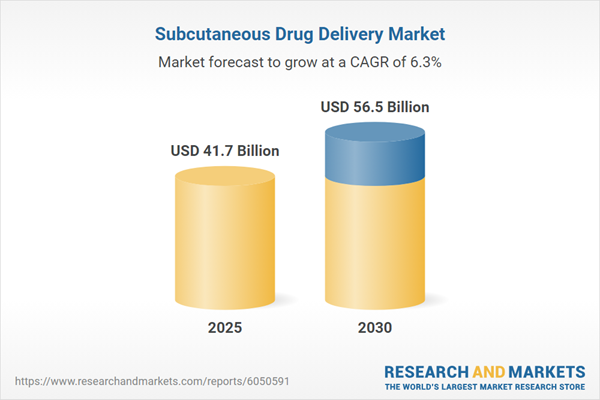The subcutaneous drug delivery market is estimated at USD41.704 billion in 2025 and is anticipated to grow at a CAGR of 6.26% during the forecast period and reach USD56.503 billion in 2030.
The market for subcutaneous drug delivery devices is experiencing rapid growth, primarily fueled by the increasing demand for advanced minimally invasive solutions. The rising prevalence of chronic conditions such as cardiovascular disease (CVD) and diabetes, along with advancements in biological drug development, is transforming the healthcare landscape.
The market for subcutaneous drug delivery devices is experiencing rapid growth, primarily fueled by the increasing demand for advanced minimally invasive solutions. The rising prevalence of chronic conditions such as cardiovascular disease (CVD) and diabetes, along with advancements in biological drug development, is transforming the healthcare landscape.
Drivers of the Subcutaneous Drug Delivery Market:
- Role of Drug-Device Systems in Chronic Disease Management: The management of chronic diseases such as asthma, multiple sclerosis, cardiovascular conditions, and diabetes presents significant global health challenges. For example, the Asthma and Allergy Foundation of America reports that asthma affects nearly 28 million people in the United States, or about 1 in 12 individuals. The adoption of drug-device delivery systems, including prefilled syringes and autoinjectors, represents a significant advancement in improving patient outcomes and reducing healthcare burdens. These systems enhance patient convenience by delivering accurate doses, thereby decreasing the need for hospital visits for clinical procedures and addressing critical gaps in chronic disease management.
Geographical Outlook of the Subcutaneous Drug Delivery Market:
- North America Expected to Hold a Major Market Share: North America is anticipated to dominate the subcutaneous drug delivery devices market during the forecast period. This growth is attributed to a well-developed healthcare infrastructure, a strong emphasis on innovation, and advanced technological capabilities within the region. The healthcare sector in North America benefits from highly developed medical facilities that provide widespread access to advanced drug delivery technologies.
Reasons for buying this report:
- Insightful Analysis: Gain detailed market insights covering major as well as emerging geographical regions, focusing on customer segments, government policies and socio-economic factors, consumer preferences, industry verticals, other sub-segments.
- Competitive Landscape: Understand the strategic maneuvers employed by key players globally to understand possible market penetration with the correct strategy.
- Market Drivers & Future Trends: Explore the dynamic factors and pivotal market trends and how they will shape up future market developments.
- Actionable Recommendations: Utilize the insights to exercise strategic decision to uncover new business streams and revenues in a dynamic environment.
- Caters to a Wide Audience: Beneficial and cost-effective for startups, research institutions, consultants, SMEs, and large enterprises.
What do businesses use our reports for?
Industry and Market Insights, Opportunity Assessment, Product Demand Forecasting, Market Entry Strategy, Geographical Expansion, Capital Investment Decisions, Regulatory Framework & Implications, New Product Development, Competitive Intelligence.Report Coverage:
- Historical data & forecasts from 2022 to 2030
- Growth Opportunities, Challenges, Supply Chain Outlook, Regulatory Framework, Customer Behaviour, and Trend Analysis
- Competitive Positioning, Strategies, and Market Share Analysis
- Revenue Growth and Forecast Assessment of segments and regions including countries
- Company Profiling (Strategies, Products, Financial Information, and Key Developments among others)
Subcutaneous Drug Delivery Market has been segmented as following:
- By Product Type:
- Prefilled syringes
- Pen injector
- Autoinjectors
- Wearable injectors
- Needle-free Injectors
- By Application:
- Diabetes
- Fertility
- Oncology
- Others
- By End-Users:
- Hospitals and Clinics
- Homecare Settings
- Ambulatory Surgical Centers
- By Geography:
- North America
- USA
- Canada
- Mexico
- South America
- Brazil
- Argentina
- Others
- Europe
- UK
- Germany
- France
- Italy
- Others
- Middle East and Africa
- Saudi Arabia
- Israel
- Others
- Asia Pacific
- Japan
- China
- India
- South Korea
- Indonesia
- Thailand
- Others
- North America
Table of Contents
1. INTRODUCTION
2. RESEARCH METHODOLOGY
3. EXECUTIVE SUMMARY
4. MARKET DYNAMICS
5. SUBCUTANEOUS DRUG DELIVERY MARKET BY PRODUCT TYPE
6. SUBCUTANEOUS DRUG DELIVERY MARKET BY APPLICATION
7. SUBCUTANEOUS DRUG DELIVERY MARKET BY END-USERS
8. SUBCUTANEOUS DRUG DELIVERY MARKET BY GEOGRAPHY
9. COMPETITIVE ENVIRONMENT AND ANALYSIS
10. COMPANY PROFILES
Companies Mentioned
- Gerresheimer AG
- Ypsomed AG
- Medtronic Plc
- Sanofi
- Novo Nordisk
- Becton, Dickinson and Company
- Elcam Medical Group
- Unilife Corporation
- Insulet Corporation
- Eli Lilly and Company
Methodology

LOADING...
Table Information
| Report Attribute | Details |
|---|---|
| No. of Pages | 145 |
| Published | January 2025 |
| Forecast Period | 2025 - 2030 |
| Estimated Market Value ( USD | $ 41.7 Billion |
| Forecasted Market Value ( USD | $ 56.5 Billion |
| Compound Annual Growth Rate | 6.2% |
| Regions Covered | Global |
| No. of Companies Mentioned | 10 |









